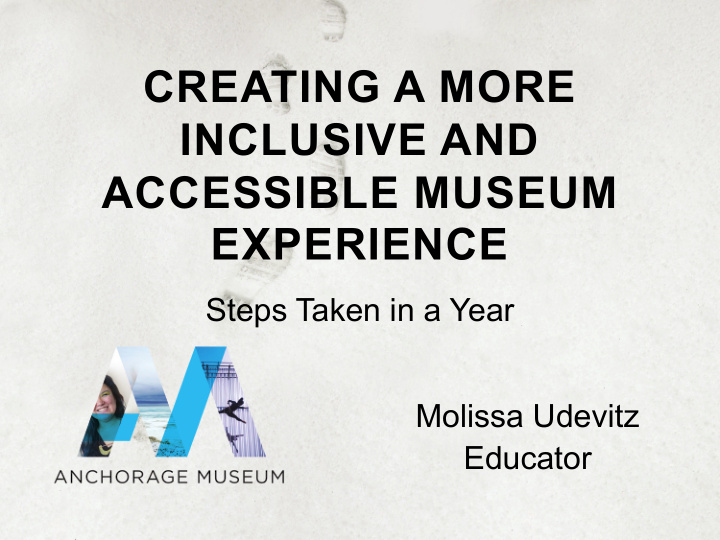



CREATING A MORE INCLUSIVE AND ACCESSIBLE MUSEUM EXPERIENCE Steps Taken in a Year Molissa Udevitz Educator
WHY INCREASE ACCESS? • Moral obligation • It benefits everyone • Aligns with museum mission and values • It is the law
FEDERAL ACCESSIBILITY LAWS NEA’s Accessibility Planning and Resource Guide for Cultural Administrators Section 504 of Rehabilitation Act (1973) and The American with Disabilities Act (1990) :
FEDERAL ACCESSIBILITY LAWS (2) NEA’s Accessibility Planning and Resource Guide for Cultural Administrators Section 504 of Rehabilitation Act (1973) and The American with Disabilities Act (1990) : 1) Prohibit discrimination 2) Require equal opportunity (and the provision of any reasonable modifications, auxiliary aids or services necessary to achieve it) 3) Require basic standard of architectural access 4) Require equal access to employment, programs, activities, goods and services
FEDERAL ACCESSIBILITY LAWS (3) NEA’s Accessibility Planning and Resource Guide for Cultural Administrators Section 504 of Rehabilitation Act (1973) and The American with Disabilities Act (1990) : 1) Prohibit discrimination 2) Require equal opportunity (and the provision of any reasonable modifications, auxiliary aids or services necessary to achieve it) 3) Require basic standard of architectural access 4) Require equal access to employment, programs, activities, goods and services
STEPS TAKEN IN THE PAST YEAR • Training • Sensory-Friendly Programming • Visitor Story Guides • Audio/Visual Descriptions • Website
INITIAL TRAINING AND PREPARATION • Walked through spaces with OTs and autism resource specialist • Training • Community contacts
SENSORY-FRIENDLY PROGRAMMING • Started Dec. 2017 • Addressed challenges • Changed to Sunday mornings • Broadened target audience • Purchase tickets at door • Get dates out early • Expanded contact list
WHAT PEOPLE LIKED: • I loved that I didn't have to worry about my daughter disturbing people visiting the museum. The cost also is great. It's easier to manage especially if she has a meltdown and we have to leave early. The employees were wonderful. I also loved the sensory items when you first walk in. Also that I can bring our other kids too for a family visit. • That my son was able to play without worrying about loud noises or there being too many people. • The quietness of the museum ... and the time for our littles to do their thing. Means so much to me.
VISITOR STORY GUIDES
PAGE 17 OF VISITOR STORY GUIDE
AUDIO/VISUAL DESCRIPTIONS
WEBSITE
WEBSITE CONTENT • Building Accessibility • Visitor Story Guides • Sensory-Friendly and Access Programs • Visual Descriptions • Professional Caregivers • Adapted School Group Field Trips • Museum Maps
THINKING BROADLY & LOOKING FORWARD • Older adults • English language learners • Immigrants and refugees • Ongoing process – not finished
RESOURCES • Anchorage Museum’s Accessibility Webpage • NEA’s Accessibility Planning and Resource Guide for Cultural Administrators • Alaska Autism Resource Center, Aimee Smith • Alaska Statewide Special Education Conference: Feb. 23-March 1, 2019 • School District Occupational Therapists, Physical Therapists, Adaptive PE Instructors, Special Education Staff • Local organizations and medical providers that work with families with special needs
CONTACT INFORMATION Molissa Udevitz 907-929-9258 mudevitz@anchoragemuseum.org
Recommend
More recommend